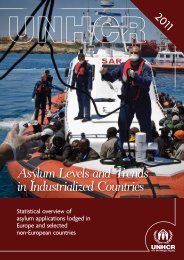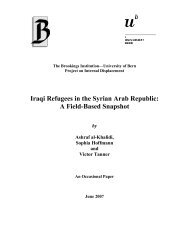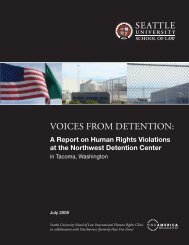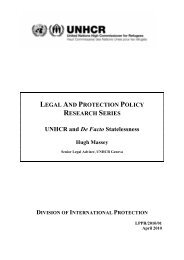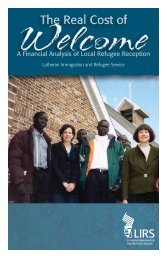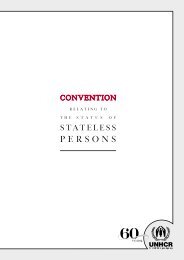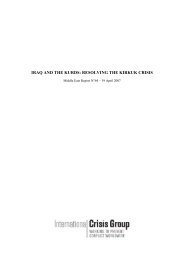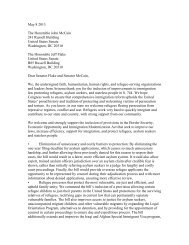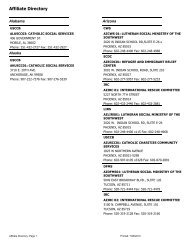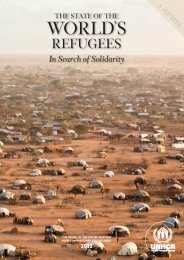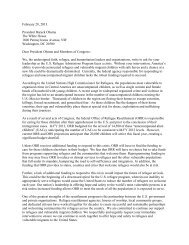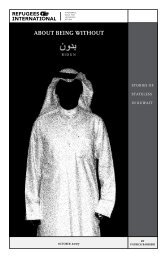Preventing and Reducing Statelessness - UNHCR
Preventing and Reducing Statelessness - UNHCR
Preventing and Reducing Statelessness - UNHCR
You also want an ePaper? Increase the reach of your titles
YUMPU automatically turns print PDFs into web optimized ePapers that Google loves.
<strong>Preventing</strong> <strong>and</strong> <strong>Reducing</strong><br />
<strong>Statelessness</strong><br />
T h e 1 9 6 1 C o n v e n t i o n o n t h e R e d u c t i o n o f S t a t e l e s s n e s s
A Personal APPeal<br />
from the United<br />
Nations high<br />
Commissioner<br />
for refugees<br />
Millions of people around the world<br />
are stateless. This is a matter of grave<br />
concern. The Convention on the Reduction<br />
of <strong>Statelessness</strong> is an important tool<br />
for tackling the problem. Many States<br />
already have legislation that is compliant<br />
with the provisions of the Convention<br />
<strong>and</strong> implementing it costs very little. Yet<br />
few States are parties to this instrument.<br />
We need to change that. I pledge the full<br />
support of my Office to governments<br />
wishing to become parties.<br />
António Guterres
P R O M O T I N G T H E R I G H T<br />
T O A N A T I O N A L I T Y<br />
Nationality is a legal bond between a person <strong>and</strong> a State. Nationality provides<br />
people with a sense of identity but, more importantly, enables them to exercise<br />
a wide range of rights. The lack of any nationality, statelessness, can therefore be<br />
harmful, in some cases devastating to the lives of the individuals concerned.<br />
Article 15 of the Universal Declaration of Human Rights affirms that “everyone<br />
has the right to a nationality”. With these words, the international community<br />
recognized that every individual, everywhere in the world, should hold a legal<br />
bond of nationality with a State. In other words, international law says clearly<br />
that statelessness should be avoided.<br />
Despite this firm international commitment, new cases of statelessness have<br />
continued to arise. Tackling statelessness still poses a major challenge in the<br />
21 st century. There are an estimated 12 million stateless people around the<br />
world today.<br />
States are responsible for conferring nationality. Each State lays down the criteria<br />
for conferral <strong>and</strong> withdrawal of nationality in its own domestic law. It is,<br />
therefore, States which must take action, alone <strong>and</strong> in cooperation with other<br />
States, to ensure that everyone has a nationality. Although the Universal Declaration<br />
of Human Rights confirms that everyone has the right to a nationality,<br />
it does not set out the specific nationality to which a person is entitled. This<br />
absence of clear rules may result in statelessness. States therefore developed a<br />
series of additional st<strong>and</strong>ards, which were adopted in 1961 in the form of the<br />
Convention on the Reduction of <strong>Statelessness</strong> (“1961 Convention”), in recognition<br />
of the need for further international cooperation <strong>and</strong> agreement to prevent<br />
<strong>and</strong> reduce statelessness.<br />
A growing number of States are turning to the 1961 Convention for guidance<br />
on how to meet their international obligation to prevent statelessness. While<br />
the 1961 Convention had only 37 States Parties on 1 January 2010, the influence<br />
of its provisions is far wider because many States have drawn elements of the<br />
Convention for inclusion in their nationality legislation.<br />
P r e v e n t i n g a n d R e d u c i n g S t a t e l e s s n e s s<br />
1
W H Y i s N A T I O N A L I T Y I M P O R T A N T <br />
Nationality provides people with a sense of identity <strong>and</strong> is key to full participation<br />
in society. Without a nationality, people are generally excluded<br />
from the political processes because they do not have the right to vote. Moreover,<br />
only ‘citizens’ have the unrestricted right to enter <strong>and</strong> reside in a country<br />
under international law. Stateless persons may therefore end up without any<br />
residence status or, worse, in prolonged detention. <strong>Statelessness</strong> also causes difficulties<br />
in a wide range of other areas, from travel to access to education <strong>and</strong><br />
healthcare. <strong>Statelessness</strong> prevents people from fulfilling their potential <strong>and</strong> may<br />
have severe knock-on effects for social cohesion <strong>and</strong> stability; it may even lead<br />
to communal tension <strong>and</strong> displacement. <strong>Preventing</strong> <strong>and</strong> reducing statelessness<br />
is an effective way to tackle one root cause of such problems.<br />
unhcr/G. Constantine<br />
W H Y i s T H E 1 9 6 1 C O N v E N T I O N<br />
R E L E v A N T T O d A Y <br />
Although it has long been understood that statelessness should be avoided<br />
<strong>and</strong> that this goal can only be achieved through international cooperation,<br />
many States have yet to take action to ensure that everyone enjoys the right to<br />
a nationality. Due to the differing approaches taken by States with regard to the<br />
acquisition <strong>and</strong> loss of nationality, some individuals continue to “fall through the<br />
cracks” <strong>and</strong> become stateless. Common rules are therefore essential to address<br />
such gaps. The 1961 Convention is the only universal instrument that elaborates<br />
clear, detailed <strong>and</strong> concrete safeguards to ensure a fair <strong>and</strong> appropriate response<br />
to the threat of statelessness. Accession to the 1961 Convention equips States to<br />
avoid <strong>and</strong> resolve nationality-related disputes <strong>and</strong> mobilize international support<br />
to adequately deal with the prevention <strong>and</strong> reduction of statelessness. A higher<br />
number of States Parties will also help to improve international relations <strong>and</strong><br />
stability by consolidating a system of common rules.<br />
2<br />
P r e v e n t i n g a n d R e d u c i n g S t a t e l e s s n e s s
A map drawn on the wall of a home in Côte d’Ivoire gives a sense of the population movements<br />
between neighbouring countries <strong>and</strong> Côte d’Ivoire before <strong>and</strong> after independence. Conflicts between<br />
the nationality laws of States can lead to statelessness. This is more likely to occur when people live<br />
outside of the country of their nationality or have children abroad. These problems can be addressed<br />
by introducing safeguards in nationality laws such as those stipulated in the 1961 Convention. Birth<br />
registration <strong>and</strong> issuance of documentation are also essential because they document the links every<br />
person has to one or more States.<br />
H O W T H E 1 9 6 1 C O N V E N T I O N H E L P S<br />
T O A V O I D S T A T E L E s s N E s s<br />
When does the 1961 Convention apply -<br />
T<br />
he 1961 Convention sets out rules for the conferral or non-withdrawal of<br />
nationality only where the person in question would be left stateless. In other<br />
words, the provisions of the 1961 Convention offer carefully detailed safeguards<br />
against statelessness that should be implemented through a State’s nationality<br />
law, without specifying any further parameters of that law. Beyond these few,<br />
simple safeguards, States are free to elaborate the content of their nationality<br />
legislation. However, these rules must be consistent with other international<br />
st<strong>and</strong>ards relating to nationality.<br />
P r e v e n t i n g a n d R e d u c i n g S t a t e l e s s n e s s 3
How CAN the 1961 Convention assist States IN reduCINg statelessness-<br />
By applying the safeguards elaborated in the 1961 Convention wherever a<br />
person would be left stateless, States can prevent new cases of statelessness<br />
from arising. The 1961 Convention’s provisions are, however, equally relevant<br />
to the task of reducing statelessness. It does this in two ways. First, prevention<br />
of statelessness leads to a reduction of statelessness over time. Second, when<br />
bringing their domestic legislation into line with the safeguards detailed in<br />
the 1961 Convention in order to prevent future statelessness, States are encouraged<br />
to also use this opportunity to reduce statelessness. For example, States<br />
may apply newly introduced safeguards retroactively <strong>and</strong> accordingly allow for<br />
acquisition of nationality by stateless people.<br />
What does the 1961 Convention ask States to do-<br />
There are four main areas in which the 1961 Convention on the Reduction<br />
of <strong>Statelessness</strong> provides concrete <strong>and</strong> detailed safeguards to be implemented<br />
by States in order to prevent <strong>and</strong> reduce statelessness. <strong>UNHCR</strong> can<br />
offer technical support to help States ensure that these safeguards are reflected<br />
in their nationality legislation <strong>and</strong> practice.<br />
><br />
Measures to avoid statelessness among children<br />
Articles 1 to 4 concern the prevention of statelessness among children.<br />
States shall grant their nationality to children who would otherwise be stateless<br />
<strong>and</strong> have ties with them through either birth in the territory or descent. As<br />
a result, where children are born in the territory but acquire the nationality<br />
of a foreign parent, there is no obligation to grant nationality. Nationality<br />
shall either be granted at birth, by operation of law, or upon application. The<br />
1961 Convention permits States to make the conferral of nationality subject<br />
to certain conditions, such as habitual residence for a certain period of time.<br />
Under Article 2, States shall grant nationality to foundlings (children found<br />
on the territory).<br />
><br />
Measures to avoid statelessness due to loss or renunciation of nationality<br />
Articles 5 to 7 prevent statelessness in later life by requiring prior possession<br />
of or assurance of acquiring another nationality before a nationality<br />
can be lost or renounced. Two exceptions to this rule are provided for: States<br />
may withdraw nationality from naturalized persons who subsequently take up<br />
long-term residence abroad <strong>and</strong> from nationals who were born abroad <strong>and</strong> are<br />
4<br />
P r e v e n t i n g a n d R e d u c i n g S t a t e l e s s n e s s
not resident in the State when they attain majority, provided certain other<br />
conditions are met.<br />
><br />
Measures to avoid statelessness due to deprivation of nationality<br />
Articles 8 <strong>and</strong> 9 of the 1961 Convention deal with the deprivation of nationality.<br />
States may not deprive any person of their nationality on racial, ethnic,<br />
religious or political grounds. Deprivation of nationality that results in statelessness<br />
is also prohibited, except where the individual obtained nationality<br />
by misrepresentation or fraud. States may retain the right to deprive a person<br />
of his or her nationality even if this leads to statelessness where he or she<br />
has committed acts inconsistent with a duty of loyalty or has made an oath<br />
or formal declaration of allegiance to another State. In deciding whether to<br />
deprive an individual of his or her nationality, the State should consider the<br />
proportionality of this measure, taking into account the full circumstances of<br />
the case. Due process guarantees need to be respected throughout the procedure<br />
regarding deprivation.<br />
><br />
Measures to avoid statelessness in the context of State succession<br />
State succession, such as the cession of territory by one State to another <strong>and</strong><br />
the creation of new States, can lead to statelessness unless proper safeguards<br />
are in place. Avoidance of statelessness in such cases is essential to promoting<br />
social inclusion <strong>and</strong> stability. Article 10 addresses the specific context of State<br />
succession <strong>and</strong> asks States to include provisions to ensure the prevention of<br />
statelessness in any treaty dealing with the transfer of territory. When no treaty<br />
is concluded, the State(s) involved shall confer its/their nationality on those who<br />
would otherwise be stateless as a result of the transfer of territory.<br />
CDoes the 1961 Convention require States to adopt the jus soli Does<br />
does the 1961 Convention require States to adopt the jus soli doctrINe-<br />
N<br />
o. The 1961 Convention does not compel States to confer nationality to<br />
all children born on their soil (jus soli doctrine) or to all children born<br />
to one of their nationals (jus sanguinis doctrine). It recognises the legitimacy of<br />
both birthplace <strong>and</strong> descent as criteria for acquisition of nationality at birth.<br />
The Convention therefore contains safeguards to avoid statelessness based on<br />
both doctrines. Where a child would otherwise be stateless <strong>and</strong> has a link<br />
based on birth on the territory or to a national, the 1961 Convention requires<br />
States Parties to grant nationality. Such conferral of nationality may be made<br />
subject to a number of additional conditions.<br />
P r e v e n t i n g a n d R e d u c i n g S t a t e l e s s n e s s 5
Is the 1961 Convention the only INstrument relevANt<br />
to the prevention ANd reduction of statelessness<br />
No. Many other international legal instruments, such as the Universal<br />
Declaration of Human Rights, recognize the right to a nationality <strong>and</strong><br />
have an impact on how States should deal with the prevention <strong>and</strong> reduction<br />
of statelessness. Examples include:<br />
• Convention on the Elimination of All Forms of Racial Discrimination which<br />
obliges States to guarantee the enjoyment of the right to a nationality without<br />
distinction as to race, colour or national or ethnic origin;<br />
• Convention on the Rights of the Child which affirms the right of every<br />
child to acquire a nationality;<br />
• Convention on the Elimination of All Forms of Discrimination Against<br />
Women which calls for equality between men <strong>and</strong> women in respect of<br />
acquisition of nationality <strong>and</strong> the transmission of nationality to children.<br />
In addition, the 1954 Convention relating to the Status of Stateless Persons,<br />
besides providing for special protective measures for stateless persons, calls upon<br />
States to facilitate naturalization in the context of resolving statelessness.<br />
There are also relevant regional st<strong>and</strong>ards helping to prevent <strong>and</strong> reduce statelessness<br />
such as Article 6 of the African Charter on the Rights <strong>and</strong> Welfare of<br />
the Child, Article 20 of the American Convention on Human Rights, Article 7<br />
of the Covenant on the Rights of the Child in Islam <strong>and</strong> a series of provisions<br />
in the European Convention on Nationality. Many States have therefore<br />
already taken on important international obligations for the promotion of the<br />
right to a nationality. These obligations are complementary to those in the 1961<br />
Convention. However, the 1961 Convention remains the only instrument offering<br />
common universal safeguards for the avoidance of statelessness. It thereby<br />
addresses nationality problems which may occur within a specific region but<br />
also those problems which require application of common rules by States in<br />
different regions.<br />
6<br />
P r e v e n t i n g a n d R e d u c i n g S t a t e l e s s n e s s
H O W U N H C R A s s I S T S S T A T E S<br />
T O A V O I D S T A T E L E s s N E s s<br />
The UN General Assembly selected <strong>UNHCR</strong> for the task of assisting States<br />
to avoid statelessness not only because refugee <strong>and</strong> statelessness problems<br />
sometimes overlap, but also because dealing with statelessness requires, in<br />
many ways, a similar approach to dealing with refugees. Both populations lack<br />
protection.<br />
<strong>UNHCR</strong> helps States to implement the 1961 Convention on the Reduction of<br />
<strong>Statelessness</strong> by offering technical advice regarding legislation <strong>and</strong> operational<br />
support to promote the implementation of measures to prevent <strong>and</strong> reduce<br />
statelessness. <strong>UNHCR</strong>’s global m<strong>and</strong>ate on statelessness is reinforced by a specific<br />
duty conferred by Article 11 of the 1961 Convention: to assist individuals<br />
who may benefit from the instrument’s provisions in presenting their claim<br />
to the appropriate State authorities.<br />
T H E L I N K W I T H T H E 1 9 5 4 C O N V E N T I O N<br />
R E L A T I N G T O T H E S T A T U S<br />
O F S T A T E L E s s P E R S O N S<br />
Even if they have acceded to <strong>and</strong> implemented the 1961 Convention on the<br />
Reduction of <strong>Statelessness</strong> <strong>and</strong> other international legal st<strong>and</strong>ards relating to<br />
the prevention <strong>and</strong> reduction of statelessness, States may still be confronted with<br />
stateless individuals or groups. It is therefore vital that there are measures in<br />
place to ensure the protection of stateless persons. The 1954 Convention relating<br />
to the Status of Stateless Persons is the primary international instrument that<br />
aims to regulate <strong>and</strong> improve the status of stateless persons <strong>and</strong> to ensure that<br />
they are accorded their fundamental rights <strong>and</strong> freedoms without discrimination.<br />
Acceding to both the 1954 <strong>and</strong> 1961 <strong>Statelessness</strong> Conventions is a key step to<br />
equip States to tackle statelessness. More detailed information about the 1954<br />
Convention can be found in Protecting the Rights of Stateless Persons – The 1954<br />
Convention relating to the Status of Stateless Persons (<strong>UNHCR</strong>, 2010).<br />
P r e v e n t i n g a n d R e d u c i n g S t a t e l e s s n e s s 7
T H E I M P O R T A N C E O F A C C E s s I O N<br />
T O T H E 1 9 6 1 C O N V E N T I O N<br />
&<br />
Acceding to the 1961 Convention on the Reduction of <strong>Statelessness</strong>:<br />
• Is a way for States to demonstrate their commitment to human rights<br />
<strong>and</strong> humanitarian st<strong>and</strong>ards, including the right to a nationality<br />
• Enables States to address gaps that result from different approaches to the<br />
attribution of nationality worldwide through the recognition of common<br />
safeguards for the avoidance of statelessness, without impinging on States’<br />
sovereignty to regulate nationality<br />
• Boosts legal transparency <strong>and</strong> predictability in States’ response to the threat<br />
of statelessness through the promotion of common safeguards<br />
• Provides States with the tools to avoid <strong>and</strong> resolve nationality-related disputes,<br />
thereby also improving international relations <strong>and</strong> stability<br />
• Prevents displacement by promoting the enjoyment of the right to a<br />
nationality<br />
• Enhances national security <strong>and</strong> stability by avoiding exclusion <strong>and</strong> marginalisation<br />
resulting from statelessness<br />
• Promotes enfranchisement <strong>and</strong> the full participation of individuals in<br />
society<br />
• Helps <strong>UNHCR</strong> to mobilise international support for the prevention <strong>and</strong><br />
reduction of statelessness<br />
8<br />
P r e v e n t i n g a n d R e d u c i n g S t a t e l e s s n e s s
Q U E S T I O N S<br />
a N S w e r s<br />
F R E Q U E N T LY A S K E D Q U E S T I O N S<br />
A B O U T A C C E s s I O N<br />
Here are answers to some of the most frequently asked questions about accession to the 1961<br />
Convention on the Reduction of <strong>Statelessness</strong>. Further questions <strong>and</strong> details are discussed in<br />
Nationality <strong>and</strong> <strong>Statelessness</strong>: A H<strong>and</strong>book for Parliamentarians (<strong>UNHCR</strong> <strong>and</strong> Inter-Parliamentary<br />
Union, 2005, updated in 2008).<br />
• Is the 1961 Convention relevant<br />
for States that have safeguards for<br />
avoiding statelessness in place<br />
Many States have already adopted safeguards<br />
in their nationality legislation in order to avoid<br />
statelessness. Even if this is the case, acceding<br />
to the 1961 Convention remains a valuable step<br />
in tackling statelessness. It lets other countries<br />
know that such safeguards are recognised by<br />
the State in question <strong>and</strong> it helps to promote<br />
worldwide acceptance of these common<br />
international st<strong>and</strong>ards.<br />
• Does the 1961 Convention<br />
compel States to allow dual<br />
nationality<br />
No. States may continue to prohibit dual<br />
nationality, as long as the laws <strong>and</strong> practices<br />
relating to the avoidance of dual nationality do<br />
not lead to statelessness. For example, a State<br />
may still require an individual to renounce their<br />
former nationality upon naturalization in order<br />
to avoid dual nationality. However, a State may<br />
not allow a person to renounce their nationality<br />
before they have gained possession or assurance<br />
of acquiring another nationality.<br />
• Does the 1961 Convention<br />
prohibit any withdrawal of<br />
nationality<br />
No. The loss or deprivation of nationality<br />
is only prohibited under the terms of the<br />
1961 Convention where this would result in<br />
statelessness. Moreover, as explained above,<br />
States may still allow for the loss or deprivation<br />
of nationality even if this leads to statelessness,<br />
in a limited number of circumstances <strong>and</strong> in<br />
accordance with the further conditions outlined<br />
in Articles 7 <strong>and</strong> 8 of the Convention.<br />
• Can a State adopt reservations<br />
to the provisions of the 1961<br />
Convention<br />
Yes. Reservations are permitted at the time<br />
of accession, but only concerning Article 11<br />
(<strong>UNHCR</strong>’s role), 14 (referral of disputes to the<br />
International Court of Justice) or 15 (territories<br />
for which the Contracting State is responsible).<br />
In accordance with Article 8, States can also<br />
adopt a declaration at the time of accession<br />
whereby they retain the right to withdraw<br />
nationality in certain limited circumstances.<br />
• What considerations are<br />
involved in acceding to the 1961<br />
Convention<br />
Acceding to the 1961 Convention implies<br />
a commitment to ensure that specific<br />
safeguards are reflected in relevant domestic<br />
legislation. This may mean adopting<br />
modifications to nationality laws – a task<br />
for which <strong>UNHCR</strong> can provide technical<br />
assistance. Thereafter, implementation of<br />
the 1961 Convention is neither costly nor<br />
P r e v e n t i n g a n d R e d u c i n g S t a t e l e s s n e s s 9
This woman is a former Soviet citizen who came to Ukraine from the Southern Caucasus. She<br />
had no valid documents but later was found to be a citizen of Georgia <strong>and</strong> obtained a passport.<br />
Prevention of statelessness often requires examining whether a person falls under nationality laws of<br />
one or more countries. Arrangements need to be in place to protect the rights of the individual until<br />
such time as their nationality can be confirmed, or if they are found to be stateless.<br />
labour intensive: for the most part the<br />
safeguards are applied automatically, just<br />
like many other provisions of nationality<br />
laws. No expensive procedures or institutions<br />
are required. The 1961 Convention does not<br />
prescribe any formal reporting obligations<br />
for States Parties. However, making<br />
information on nationality laws available<br />
to other States <strong>and</strong> <strong>UNHCR</strong> is an important<br />
means of ensuring that the safeguards are<br />
implemented correctly by all States Parties.<br />
• How does a State accede to the<br />
1961 Convention<br />
States may accede to the 1961 Convention<br />
at any time by depositing an instrument of<br />
accession with the Secretary-General of the<br />
United Nations. The instrument of accession<br />
must be signed by the Foreign Minister or<br />
the Head of State or Government. Further<br />
details on accession procedures <strong>and</strong> model<br />
instruments of accession can be found at<br />
www.unhcr.org/statelessness.<br />
10<br />
P r e v e n t i n g a n d R e d u c i n g S t a t e l e s s n e s s
i n t e r n a t i o n a l C A L L s F O R A C C E s s I O N<br />
unchr/G. Constantine<br />
UN General Assembly: Notes that sixty-five States are now parties to the 1954 Convention<br />
relating to the Status of Stateless Persons <strong>and</strong> that thirty-seven States are<br />
parties to the 1961 Convention on the Reduction of <strong>Statelessness</strong>, encourages States<br />
that have not done so to give consideration to acceding to those instruments.<br />
• General Assembly Resolution 64/127, Office of the United Nations High Commissioner<br />
for Refugees, 18 December 2009<br />
UN Human Rights Council: Acknowledges that 2011 will mark the fiftieth anniversary<br />
of the Convention on the Reduction of <strong>Statelessness</strong>, <strong>and</strong> encourages States<br />
that have not acceded to the Convention <strong>and</strong> the Convention relating to the Status<br />
of Stateless Persons to consider doing so.<br />
• Human Rights Council Resolution 13/02, Human rights <strong>and</strong> arbitrary deprivation of<br />
nationality, 24 March 2010<br />
<strong>UNHCR</strong> Executive Committee: Encourages States to give consideration to acceding<br />
to the 1961 Convention on the Reduction of <strong>Statelessness</strong> <strong>and</strong>, in regard to States<br />
Parties, to consider lifting reservations.<br />
• Conclusion No. 106 (LVII) – 2006<br />
Asian-African Legal Consultative Organization: Invites Member States to consider<br />
the possibility of acceding to the 1954 Convention relating to the Status of Stateless<br />
Persons <strong>and</strong> the 1961 Convention on the Reduction of <strong>Statelessness</strong> to address the<br />
plight of stateless persons in an effective way.<br />
• Resolution on the Half-Day Special Meeting on “Legal Identity <strong>and</strong> <strong>Statelessness</strong>”,<br />
8 April 2006<br />
General Assembly of the Organisation of American States: Resolves 1. To emphasize<br />
the importance of the universal instruments for the protection of stateless persons:<br />
the 1954 Convention Relating to the Status of Stateless Persons <strong>and</strong> the 1961<br />
Convention on the Reduction of <strong>Statelessness</strong>. 2. To urge those member states that<br />
have not yet done so to consider ratifying or acceding to, as the case may be, the<br />
international instruments in the area of stateless persons, <strong>and</strong> to promote the adoption<br />
of procedures <strong>and</strong> institutional mechanisms for their application, in accordance<br />
with those instruments.<br />
• Resolution of the General Assembly, AG/RES. 2599 (XL-O/10), Prevention <strong>and</strong><br />
Reduction of <strong>Statelessness</strong> <strong>and</strong> Protection of Stateless Persons in the Americas, 8 June<br />
2010<br />
P r e v e n t i n g a n d R e d u c i n g S t a t e l e s s n e s s 11
Annex 1<br />
M o d E L I n s T R U M E N T O F A C C E s s I O N T O<br />
T H E C O N v E N T I O N O N T H E R e d U C T I O N<br />
O F s T A T E L E s s N E s s O F 1 9 6 1<br />
WHEREAS a Convention on the Reduction of <strong>Statelessness</strong> was adopted by the<br />
Plenipotentiaries on the thirtieth day of August, one thous<strong>and</strong> nine hundred<br />
<strong>and</strong> sixty-one, <strong>and</strong> is open for accession pursuant to Article 16 thereof;<br />
AND WHEREAS, it is provided in section 4 of the said Article 16 that accession<br />
thereto shall be affected by deposit of an instrument with the Secretary<br />
General of the United Nations;<br />
NOW THEREFORE, the undersigned, [Title of Head of State, Head of<br />
Government or Foreign Minister] hereby notifies the accession of the [State<br />
concerned];<br />
GIVEN under my h<strong>and</strong> in _______________ this _______ day of______ two<br />
thous<strong>and</strong> <strong>and</strong> _______.<br />
[Public Seal <strong>and</strong> Signature of custodian if appropriate]<br />
[Signature of Head of State, Head of Government or Foreign Minister]<br />
12<br />
P r e v e n t i n g a n d R e d u c i n g S t a t e l e s s n e s s
Cover :<br />
A Nepalese boy from the marginalised<br />
Dalit community rests next to his<br />
gr<strong>and</strong>father. Disadvantaged communities<br />
in Nepal have often faced multiple<br />
obstacles to citizenship <strong>and</strong> the exercise<br />
of associated rights. For many people<br />
around the world, statelessness begins<br />
at birth, often because the parents<br />
themselves are stateless.<br />
The 1961 Convention on the Reduction<br />
of <strong>Statelessness</strong> is designed to ensure<br />
that every child can acquire a nationality<br />
<strong>and</strong> that statelessness is not transmitted<br />
from one generation to another.<br />
G. CoNSTANTine<br />
I would like more information about:<br />
<strong>UNHCR</strong> <strong>and</strong> its work on statelessness<br />
Visit <strong>UNHCR</strong>’s statelessness website at<br />
www.unhcr.org/statelessness. You can also<br />
consult the Conclusions on International<br />
Protection of <strong>UNHCR</strong>’s Executive Committee,<br />
in particular Conclusion 106 on Identification,<br />
Prevention <strong>and</strong> Reduction of <strong>Statelessness</strong> <strong>and</strong><br />
Protection of Stateless Persons (2006).<br />
<strong>UNHCR</strong> / DIP•STATELESSNESS / Q&A A.7 / ENG3<br />
Published by:<br />
<strong>UNHCR</strong><br />
P.O. Box 2500<br />
1211 Geneva 2<br />
Switzerl<strong>and</strong><br />
<strong>UNHCR</strong>, September 2010<br />
International law relating to<br />
the prevention <strong>and</strong> reduction of<br />
statelessness, including the 1961<br />
Convention on the Reduction of<br />
<strong>Statelessness</strong><br />
For a more detailed discussion of the 1961<br />
Convention as well as other international<br />
norms relating to the right to a nationality<br />
<strong>and</strong> the avoidance of statelessness, see<br />
Nationality <strong>and</strong> <strong>Statelessness</strong>: A H<strong>and</strong>book<br />
for Parliamentarians (<strong>UNHCR</strong> <strong>and</strong><br />
Inter-Parliamentary Union, 2005, updated in<br />
2008). To access other relevant international<br />
documents, visit <strong>UNHCR</strong>’s Refworld website<br />
at www.refworld.org.




